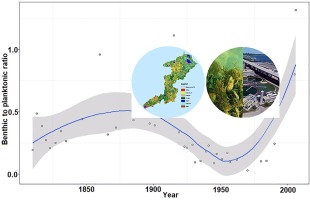Ecological Indicators ( IF 7.0 ) Pub Date : 2020-03-14 , DOI: 10.1016/j.ecolind.2020.106284 Bo Liu , Shuo Chen , Hui Liu , Yueqiang Guan

|
Ratio of benthic to planktonic diatoms has been used to indicate lake changes related to light availability reaching the bottom of the lake, such as changes in water clarity with eutrophication and changes in water depth. To explore using of the ratio to track long-term changes of eutrophication status of Muskegon Lake, we analyzed relationships between the ratio and land use change information, inferred TP based on diatoms from different habitats a good history of spatially and temporally isolated changes in the watershed and geochemistry indices of a long sediment core retrieved from the lake. We found the ratio related well with diatom-inferred TP (DI-TP) and geochemistry proxies at different temporal and spatial scales. From European settlement to around 1920, the ratios are relatively stable and indicates a relatively high natural nutrient status of the lake. When manufacturing and population boomed in the Muskegon River Watershed, the ratios greatly decreased with the increase of DI-TP and measured geochemistry proxies. Our results showed the decrease of the ratio was most possibly due to the increase of urban land use throughout watershed during this period. Both the ratio and the water clarity sharply increased in around 1973, which was probably caused by the great decrease of the nutrients input from the watershed. Low nutrient concentrations resulted in the collapse of eutrophic planktonic diatom community. Dreissenid mussel invasion might not have a great influence on the ratios because either quagga or zebra mussel did not increase to sufficiently high abundances in the 1990s in Muskegon Lake. On the other hand, the substrate of Muskegon Lake is not suitable for dreissenid mussel colonization. Performance of the ratio on indicating trophic status of the complex case of Muskegon Lake suggested the ratio would be a promising indicator for evaluating eutrophication status in lakes.
中文翻译:

随时间变化的马斯基根湖底栖硅藻和浮游硅藻比率与富营养化状态的变化:对水质有价值指标的启示
底栖硅藻与浮游硅藻的比率已被用于指示与到达湖泊底部的光可利用性相关的湖泊变化,例如富营养化后水的透明度的变化和水深的变化。为了探索利用该比率跟踪马斯基根湖富营养化状态的长期变化,我们分析了该比率与土地利用变化信息之间的关系,基于来自不同生境的硅藻推断出的TP具有良好的时空变化的历史。从湖中回收的长沉积物核心的流域和地球化学指标。我们发现该比例与硅藻推断的TP(DI-TP)和不同时空尺度的地球化学代理相关。从欧洲殖民时期到1920年左右,这些比率相对稳定,表明该湖的自然营养状况相对较高。当马斯基根河流域的制造业和人口激增时,比率随着DI-TP和实测地球化学代理的增加而大大降低。我们的结果表明,该比率的降低很可能是由于在此期间整个流域内城市土地利用的增加。比率和水的净度都在1973年左右急剧增加,这可能是由于流域输入的养分大大减少所致。低养分浓度导致富营养化浮游硅藻群落的崩溃。Dreissenid贻贝的入侵可能对比率没有太大影响,因为1990年代马斯基根湖的quagga或斑马贻贝都没有增加到足够高的丰度。另一方面,马斯基根湖的底物不适合于苔藓类贻贝定殖。该比率在指示马斯基根湖复杂情况下的营养状态方面的性能表明,该比率将是评估湖泊富营养化状况的有前途的指标。











































 京公网安备 11010802027423号
京公网安备 11010802027423号